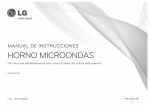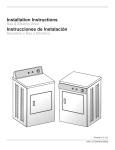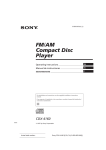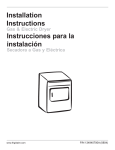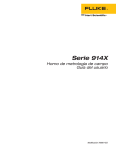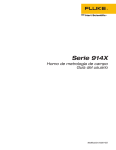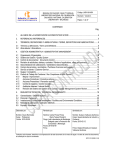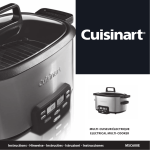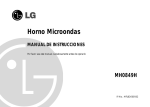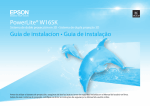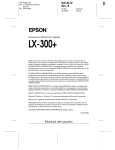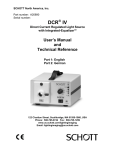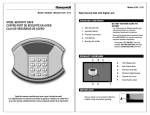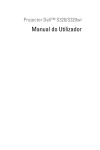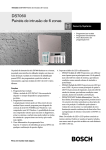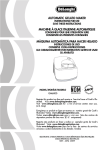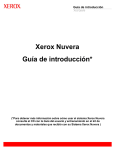Download Gas & Electric Dryer Secadora a gas y eléctrica
Transcript
® Gas & Electric Dryer Installation Instructions Secadora a gas y eléctrica Instrucciones para la instalación P/N 134199600H (0804) Sears, Roebuck and Co., Hoffman Estates, IL 60179 U.S.A. www.sears.com CONTENTS Pre-Installation Requirements..........................................................................................................................................2 Electrical Requirements..................................................................................................................................................3 Exhaust System Requirements......................................................................................................................................3-4 Gas Supply Requirements............................................................................................................................................4-5 Location of Your Dryer....................................................................................................................................................5 Rough-In Dimensions.....................................................................................................................................................6 Mobile Home Installation...............................................................................................................................................7 Unpacking ...................................................................................................................................................................7 Reversing Door Swing.................................................................................................................................................8 Electrical Installation....................................................................................................................................................9 Grounding Requirements..............................................................................................................................................9 Electrical Connections—3-wire.......................................................................................................................................9 Electrical Connections—4-wire........................................................................................................................................10 Gas Connection............................................................................................................................................................10 General Installation.......................................................................................................................................................10 Replacement Parts........................................................................................................................................................10 Español........................................................................................................................ ..........11-20 SAFETY INSTRUCTIONS Clothes dryer installation and service must be performed by a qualified installer, service agency or the gas supplier. Install the clothes dryer according to the manufacturer's instructions and local codes. Before beginning installation, carefully read these instructions. This will simplify the installation and ensure the dryer is installed correctly and safely. Leave these instructions near the Dryer after installation for future reference. NOTE: The electrical service to the Dryer must conform with local codes and ordinances and the latest edition of the National Electrical Code, ANSI/NFPA 70, or in Canada, the Canadian electrical code C22.1 part 1. NOTE: The gas service to the Dryer must conform with local codes and ordinances and the latest edition of the National Fuel Gas Code ANSI Z223.1, or in Canada, CAN/ACG B149.1-2000 NOTE: The Dryer is designed under ANSI Z 21.5.1 or ANSI/UL 2158 - CAN/CSA C22.2 No. 112 (latest editions) for HOME USE only. This Dryer is not recommended for commercial applications such as restaurants or beauty salons, etc. Your safety and the safety of others is very important. We have provided many important safety messages in the Use & Care Guide, Operating Instructions, Installation Instructions and on your appliance. Always read and obey all safety messages. This is the safety alert symbol. This symbol alerts you to hazards that can kill or hurt you or others. All safety messages will be preceded by the safety alert symbol and the word "DANGER" or "WARNING". These words mean: DANGER You will be killed or seriously injured if you don't follow instructions. You can be killed or seriously injured if you don't follow instructions. All safety messages will identify the hazard, tell you how to reduce the chance of injury, and tell you what can happen if the instructions are not followed. RISK OF FIRE. For your safety the information in this manual must be followed to minimize the risk of fire or explosion or to prevent property damage, personal injury or loss of life. SAVE THESE INSTRUCTIONS. - Do not store or use gasoline or other flammable vapors and liquid in the vicinity of this or any other appliance. - WHAT TO DO IF YOU SMELL GAS · Do not try to light any appliance. · Do not touch any electrical switch; do not use any phone in your building. · Clear the room, building or area of all occupants. · Immediately call your gas supplier from a neighbor’s phone. Follow the gas supplier's instructions. · If you cannot reach your gas supplier, call the fire department. Installation and service must be performed by a qualified installer, service agency or the gas supplier. PRE-INSTALLATION REQUIREMENTS Tools and Materials Required for Installation: 1. Phillips head screwdriver. 2. Channel-lock adjustable pliers. 3. Carpenter's level. 4. Flat or straight blade screwdriver. 5. Duct tape. 6. Rigid or flexible metal 4 inch (10.2 cm) duct. 7. Vent hood. 8. Pipe thread sealer (Gas). 9. Plastic knife. 2 2 ELECTRICAL REQUIREMENTS EXHAUST SYSTEM REQUIREMENTS Use only 4 inch (10.2 cm) diameter (minimum) rigid or flexible metal duct and approved vent hood which has a swing-out damper(s) that open when the dryer is in operation. When the dryer stops, the dampers automatically close to prevent drafts and the entrance of insects and rodents. To avoid restricting the outlet, maintain a minimum of 12 inches (30.5 cm) clearance between the vent hood and the ground or any other obstruction. ELECTRIC Dryer CIRCUIT - Individual 30 amp. branch circuit fused with 30 amp. time delay fuses or circuit breakers. Use separately fused circuits for washers and dryers, and DO NOT operate a washer and a dryer on the same circuit. POWER SUPPLY - 3 wire or 4-wire, 240 volt, single phase, 60 Hz, Alternating Current. The following are specific requirements for proper and safe operation of your dryer. Failure to follow these instructions can create excessive drying times and fire hazards. POWER SUPPLY CORD KIT - 3 wire - the dryer MUST employ a 3-conductor power supply cord NEMA 10-30 type SRDT rated at 240 volt AC minimum, 30 amp., with 3 open end spade lug connectors with upturned ends or closed loop connectors and marked for use with clothes dryers. See ELECTRICAL CONNECTIONS FOR A 3-WIRE SYSTEM. Do not install a clothes dryer with flexible plastic venting materials. If your present system is made up of plastic duct or metal foil duct, replace it with a rigid or semirigid metal duct. In Canada and the United States if metal (foil type) duct is installed, it must be of a specific type identified by the appliance manufacturer as suitable for use with clothes dryers and in the United States must also comply with the Outline for Clothes Dryer Transition Duct, UL standard 2158A. Flexible venting materials are known to collapse, be easily crushed and trap lint. These conditions will obstruct clothes dryer airflow and increase the risk of fire. Ensure the present duct is free of any lint prior to installing dryer duct. 4 wire - The dryer MUST employ a 4-conductor power supply cord NEMA 14-30 type SRDT or ST (as required) rated at 240 volt AC minimum, 30 amp., with 4 open end spade lug connectors with upturned ends or closed loop connectors and marked for use with clothes dryers. See ELECTRICAL CONNECTIONS FOR A 4-WIRE SYSTEM. (Canada - 4-wire power supply cord is installed on dryer.) WARNING – Risk of Shock. Appliance grounded to neutral conductor through a link. Grounding through the neutral link is prohibited for (1) New branch circuit installations (2) mobile homes; (3) recreational vehicles; and (4) areas where local codes do not permit grounding through the neutral, (1) disconnect the link from the neutral, (2) use grounding terminal or lead to ground appliance in accordance with local codes and (3) connect neutral terminal or lead to branch circuit neutral in usual manner (if the appliance is to be connected by means of a cord kit, use 4-conductor cord for this purpose). USE COPPER CONDUCTOR ONLY. OUTLET RECEPTACLE - NEMA 10-30R receptacle to be located so the power supply cord is accessible when the dryer is in the installed position. (Canada - NEMA 14-30R receptacle.) NEMA 10-30R NEMA 14-30R GAS Dryer CIRCUIT - Individual 15 amp. branch circuit fused with a 15 amp. maximum time delay fuse or circuit breaker. POWER SUPPLY - 3 wire, 120 volt single phase, 60 Hz, Alternating Current. POWER SUPPLY CORD - The dryer is equipped with a 120 volt 3-wire power cord. NOTE: Do not under any circumstances remove grounding prong from plug . GROUNDING PRONG 3 - Risk of Fire - A clothes dryer must be exhausted outdoors. Do not exhaust dryer into a chimney, a wall, a ceiling, an attic, a crawl space or any concealed space of a building. A clothes dryer produces combustible lint. If the dryer is not exhausted outdoors, some fine lint will be expelled into the laundry area. An accumulation of lint in any area of the home can create a health and fire hazard. The dryer must be connected to an exhaust outdoors. Regularly inspect the outdoor exhaust opening and remove any accumulation of lint around the outdoor exhaust opening and in the surrounding area. 1. Connect an inclined or digital manometer between the Do not allow combustible materials (for dryer and the point the exhaust connects to the dryer. example: clothing, draperies/curtains, paper) to come in 2. Set the dryer timer and temperature to air fluff (cool down) contact with exhaust system. The dryer MUST NOT be and start the dryer. exhausted into a chimney, a wall, a ceiling, or any concealed space of a building which can accumulate lint, resulting in a fire 3. Read the measurement on the manometer. 4. The system back pressure MUST NOT be higher than 0.75 hazard. inches of water column. If the system back pressure is less Exceeding the length of duct pipe or number than 0.75 inches of water column, the system is acceptable. of elbows allowed in the "MAXIMUM LENGTH" charts can If the manometer reading is higher than 0.75 inches of water cause an accumulation of lint in the exhaust system. Plugging column, the system is too restrictive and the installation is the system could create a fire hazard, as well as increase drying unacceptable. times. Although vertical orientation of the exhaust system is acceptable, Do not screen the exhaust ends of the vent certain extenuating circumstances could affect the performance system, nor use any screws, rivets or other fastening means of the dryer: that extend into the duct and catch lint to assemble the exhaust system. Lint can become caught in the screen, on the • Only the rigid metal duct work should be used. screws or rivets, clogging the duct work and creating a fire hazard • Venting vertical through a roof may expose the exhaust system to down drafts causing an increase in vent restriction. as well as increasing drying times. Use an approved vent hood to terminate the duct outdoors, and seal all joints with duct tape. • Running the exhaust system through an uninsulated area may cause condensation and faster accumulation of lint. All male duct pipe fittings MUST be installed downstream with the flow of air. • Compression or crimping of the exhaust system will cause an increase in vent restriction. Explosion hazard. Do not install the dryer The exhaust system should be inspected and cleaned a minimum where gasoline or other flammables are kept or stored. If the dryer is installed in a garage, it must be a minimum of 18 of every 18 months with normal usage. The more the dryer is inches (45.7 cm) above the floor. Failure to do so can result in used, the more often you should check the exhaust system and vent hood for proper operation. death, explosion, fire or burns. MAXIMUM LENGTH of 4” (10.2 cm) Dia. Rigid Metal Duct Number of 90° Turns 0 VENT HOOD TYPE (Preferred) Louvered 4” (10.2 cm) 60 ft.(18.28 m) 2½" (6.35 cm) 48 ft.(14.63 m) 1 52 ft.(15.84 m) 40 ft.(12.19 m) 2 44 ft.(13.41 m) 32 ft. (9.75 m) 3 32 ft.(9.75 m) 24 ft. (7.31 m) 4 28 ft.(8.53 m) 16 ft. (4.87 m) Number of 90° Turns EXHAUST DIRECTION All dryers shipped from the factory are set up for rear exhausting. However, on electric dryers, exhausting can be to the right or left side of the cabinet or the bottom of the dryer. On gas dryers, exhausting can be to the right side of the cabinet or the bottom of the dryer. Directional exhausting can be accomplished by installing Exhaust Kit, P/N 131456800, available through your parts distributor. Follow the instructions supplied with the kit. EXHAUST DUCT LOCATING DIMENSIONS SAME AS OTHER SIDE MAXIMUM LENGTH 5 7/8" of 4” (10.2 cm) Dia. Flexible Metal Duct VENT HOOD TYPE (Preferred) Louvered 13 1/2" 4 3/8" 3 3/4" 3 3/4" 0 4” (10.2 cm) 30 ft. (9.14 m) 2½" (6.35 cm) 18 ft. (5.49 m) 1 22 ft. (6.71 m) 14 ft. (4.27 m) 2 14 ft. (4.27 m) 10 ft. (3.05 m) (9.5 cm) GAS SUPPLY REQUIREMENTS Replace copper connecting pipe that is not plastic-coated. Stainless steel or plastic-coated brass MUST 3 NOT RECOMMENDED be used. 1. Installation MUST conform with local codes, or in the absence of local codes, with the National Fuel Gas Code, ANSI Z223.1 CORRECT INCORRECT (latest edition). 2. The gas supply line should be of 1/2 inch (1.27 cm) pipe. 3. If codes allow, flexible metal tubing may be used to connect INSTALL MALE FITTINGS IN CORRECT DIRECTION your dryer to the gas supply line. The tubing MUST be In installations where the exhaust system is not described in the constructed of stainless steel or plastic-coated brass. charts, the following method must be used to determine if the 4. The gas supply line MUST have an individual shutoff valve. exhaust system is acceptable: 4 5. A 1/8 inch (0.32 cm) N.P.T. plugged tapping, accessible for test gauge connection, MUST be installed immediately upstream of the gas supply connection to the dryer. 60 SQ. IN. (387.1 SQ. CM) 6. The dryer MUST be disconnected from the gas supply piping system during any pressure testing of the gas supply piping system at test pressures in excess of 1/2 psig (3.45 kPa). 7. The dryer MUST be isolated from the gas supply piping system during any pressure testing of the gas supply piping system at test pressures equal to or less than 1/2 psig (3.45 kPa). 60 SQ. IN. (387.1 SQ. CM) CLOSET DOOR LOCATION OF YOUR DRYER DO NOT INSTALL YOUR DRYER: 1. In an area exposed to dripping water or outside weather conditions. 2. In an area where it will come in contact with curtains, drapes, or anything that will obstruct the flow of combustion and ventilation air. 3. On carpet. Floor MUST be solid with a maximum slope of 1 inch (2.54 cm). INSTALLATION IN RECESS OR CLOSET 1. A dryer installed in a bedroom, bathroom, recess or closet, MUST be exhausted outdoors. 2. No other fuel burning appliance shall be installed in the same closet as the Gas dryer. 3. Your dryer needs the space around it for proper ventilation. DO NOT install your dryer in a closet with a solid door. 4. A minimum of 120 square inches (774.2 square cm) of opening, equally divided at the top and bottom of the door, is required. Air openings are required to be unobstructed when a door is installed. A louvered door with equivalent air openings for the full length of the door is acceptable. 0" (0 cm) 1" (2.54 cm) 0" (0 cm) NOTE: Under counter and stack models - 0 inches (0 cm) for sides, rear, and top. 0" (0 cm) 1" (2.54 cm) 0" (0 cm) 0" (0 cm) MINIMUM INSTALLATION CLEARANCES Inches (cm) SIDES REAR TOP FRONT Alcove 0 (0 cm) 0 (0 cm) Closet 0 (0 cm) 0 (0 cm) 1 (2.54 cm) Closet door ventilation required: 2 louvered openings each 60 square inches (387 square centimeters) — 3 inches (7.6 cm) from bottom and top of door. This dryer MUST be exhausted outdoors. 5. The following illustrations show minimum clearance dimensions for proper operation in a recess or closet installation. 15" (38.1 cm) UNDER COUNTER INSTALLATION If an under counter* installation is desired, the dryer MUST have a top sheet kit installed, P/N 131629100. Kit is available from an authorized parts distributor. *Custom-sized countertop is required. 5 TOP CONSOLE MODELS ROUGH-IN DIMENSIONS UNDER COUNTER & STACK MODELS ROUGH-IN DIMENSIONS (68.3 cm) (68.3 cm) ELECTRIC CONNECTION ELECTRIC CONNECTION UNDER COUNTER 34 5/8" (87.9 cm) (6.5 cm) (6.5 cm) 13 1/2" (34.4 cm) 13 1/2" (34.4 cm) (110.7 cm) 36" (91.5 cm) 36" (91.5 cm) (9.5 cm) 3/8" (0.96 cm) DIA. GAS PIPE (2.54 cm) (9.5 cm) REAR VIEW 47 1/2" (120.7 cm) 3/4" (1.9 cm) 4 3/8" (11.1 cm) 4 3/8" (11.1 cm) OPTIONAL VENT KNOCKOUT SIDE VIEW (2.54 cm) REAR VIEW 47 1/2" (120.7 cm) (68.6 cm) 3/8" (0.96 cm) DIA. GAS PIPE OPTIONAL VENT KNOCKOUT 3 3/4" (9.5 cm) (68.6 cm) SIDE VIEW 6 3 3/4" (9.5 cm) MOBILE HOME INSTALLATION UNPACKING 1. Using the four shipping carton corner posts (two on each side), carefully lay the dryer on its left side and remove foam shipping base. 1. Dryer MUST be exhausted outside (outdoors, not beneath the mobile home) using metal ducting that will not support combustion. Metal ducting must be 4 inches (10.16 cm) in diameter with no obstructions. Rigid metal duct is preferred. 2. If dryer is exhausted through the floor and area beneath the mobile home is enclosed, the exhaust system MUST terminate outside the enclosure with the termination securely fastened to the mobile home structure. 3. When installing a gas dryer into a mobile home, a provision must be made for outside make up air. This provision is to be not less than twice the area of the dryer exhaust outlet. 4. This dryer MUST be fastened to the floor. Mobile Home Installation Kit No. 169840 is available from your dealer. 5. Refer to pages 2 and 3 for other important venting requirements. 6. Installation MUST conform to current Manufactured Home Construction & Safety Standard (which is a Federal Regulation Title 24 CFR-Part 32-80) or when such standard is not applicable, with American National Standard for Mobile Homes. In Canada, the CSA Z240 is applicable. To prevent damage, do not use the control panel as a means to pick up or move the dryer. NOTE: On under counter model clothes dryers, the top panel may be removed for installation. 2. Return the dryer to an upright position. FOAM SHIPPING PACKING The dryer is designed under ANSI Z 21.5.1 for HOME USE only. REVERSING DOOR SWING OK Your dryer is designed so the door swing may be reversed at any time without additional parts. Conversion is accomplished by transferring hinges to the opposite side of the cabinet. DON’T To change the direction of the door opening: Correct OK Correct OK Correct 1. Open the dryer door. Remove the four hinge hole plugs from the left side of the door opening. Place nearby for future installation. NOTE: You may need a plastic knife to help pull out the plugs. Be careful not to scratch the paint. 2. Remove the four screws that secure the door hinges to the dryer front panel (see below). NOTE: Remove one screw from each of the two hinges first. Hold the door firmly before removing the last two screws. 3. Rotate the door 180° and reinstall the door hinges to the dryer front panel with the four screws. 4. Install the four hinge hole plugs in the open screw holes on the right side of the door opening. Incorrect DON’T Incorrect DON’T REMOVE 4 SCREWS (ONE FROM EACH HINGE FIRST) Incorrect 7 ELECTRICAL INSTALLATION ALL ELECTRIC Dryers Canadian ELECTRIC Dryer The following are specific requirements for proper and safe electrical installation of your dryer. Failure to follow these instructions can create electrical shock and/ or a fire hazard. DANGER Improper connection of the equipment grounding conductor can result in a risk of electrical shock. Check with a licensed electrician if you are in doubt as to whether the appliance is properly grounded. For a grounded, cord-connected dryer: 1. The dryer must be grounded. In the event of a malfunction or breakdown, grounding will reduce the risk of electrical shock by a path of least resistance for electrical current. This appliance MUST be properly grounded. Electrical shock can result if the dryer is not properly grounded. Follow the instructions in this manual for proper grounding. Do not use an extension cord with this dryer. Some extension cords are not designed to withstand the amounts of electrical current this dryer utilizes and can melt, creating electrical shock and/or fire hazard. Locate the dryer within reach of the receptacle for the length power cord to be purchased, allowing some slack in the cord. Refer to the pre-installation requirements in this manual for the proper power cord to be purchased. 2. Since your dryer is equipped with a power supply cord having an equipment-grounding conductor and a grounding plug, the plug must be plugged into an appropriate outlet that is properly installed and grounded in accordance with all local codes and ordinances. If in doubt, call a licensed electrician.Do not modify plug provided with the appliance. A U.L. approved strain relief must be installed onto power cord. If the strain relief is not attached, the cord can be pulled out of the dryer and can be cut by any movement of the cord, resulting in electrical shock. ALL GAS Dryers 1. The dryer is equipped with a three-prong (grounding) plug for your protection against shock hazard and should be plugged directly into a properly grounded three-prong receptacle. Do not cut or remove the grounding prong from the plug. Do not use an aluminum wired receptacle with a copper wired power cord and plug (or vice versa). A chemical reaction occurs between copper and aluminum and can cause electrical shorts. The proper wiring and receptacle is a copper wired power cord with a copper wired receptacle. NOTE: Dryers operating on 208 volt power supply will have longer drying times than operating on 240 volt power supply. GROUNDING REQUIREMENTS Non-Canadian ELECTRIC Dryer DANGER Improper connection of the equipment grounding conductor can result in a risk of electrical shock. Check with a licensed electrician if you are in doubt as to whether the appliance is properly grounded. For a grounded, cord-connected dryer: 1. The dryer MUST be grounded. In the event of a malfunction or breakdown, grounding will reduce the risk of electrical shock by a path of least resistance for electrical current. 2. If your dryer is equipped with a power supply cord having an equipment-grounding conductor and a grounding plug, the plug MUST be plugged into an appropriate, copper wired receptacle that is properly installed and grounded in accordance with all local codes and ordinances. If in doubt, call a licensed electrician. Do not modify plug provided with the appliance. For a permanently connected dryer: 1. The dryer MUST be connected to a grounded metal, permanent wiring system; or an equipment grounding conductor must be run with the circuit conductors and connected to the equipment-grounding terminal or lead on the appliance. 8 ELECTRICAL CONNECTIONS FOR 3-WIRE SYSTEM ELECTRICAL CONNECTIONS FOR 4-WIRE SYSTEM Non-Canadian ELECTRIC Dryer Non-Canadian ELECTRIC Dryer 1. Remove the screws securing the terminal block access cover and the strain relief mounting bracket located on the back of the dryer upper corner. 1. Remove the screws securing the terminal block access cover and the strain relief mounting bracket located on the back of the dryer upper corner. 2. Install a U.L. approved strain relief in the entry hole of the mounting bracket. Finger tighten the nut only at this time. 2. Install a U.L. approved strain relief into the power cord entry hole of the mounting bracket. Finger tighten the nut only at this time. GREEN GROUND SCREW GREEN POWERCORD GROUND WIRE SILVER TERMINAL TERMINAL BLOCK GREEN GROUND SCREW SILVER TERMINAL NEUTRAL GROUND WIRE NEUTRAL GROUND WIRE RED NUT TIGHTEN NUT TO THESE THREADS BLACK TIGHTEN NUT TO THESE WHITE THREADS NUT STRAIN RELIEF MOUNTING BRACKET POWER CORD 3. Remove the ground wire from the green ground screw located above the terminal block. STRAIN RELIEF MOUNTING BRACKET TYPICAL 4 CONDUCTOR BLACK WHITE POWER CORD TYPICAL 4 CONDUCTOR 3. Thread a U.L. approved 30 amp. power cord, NEMA 10-30 Type SRDT, through the strain relief. RED 240V GREEN 30 AMP NEMA 14-30 TYPE SRDT OR 4. Thread a U.L. approved 30 amp power cord, NEMA 14-30 type ST or SRDT through the strain relief. 4. Attach the power cord neutral (center wire) conductor to the silver colored center terminal on the terminal block. Tighten the screw securely. 5. Attach the green power cord ground wire to the cabinet with the green ground screw. 5. Attach the remaining two power cord outer conductors to the outer brass colored terminals on the terminal block. Tighten both screws securely. 6. Attach the white (neutral) power cord conductor from the power cord and the neutral ground wire from the dryer harness to the silver-colored center terminal on the terminal block. Tighten the screw securely. Do not make a sharp bend or crimp wiring/ conductor at connections. 7. Attach the red and black power cord conductors to the outer brass-colored terminals on the terminal block. 6. Reattach the strain relief mounting bracket to the back of the dryer with two screws. Tighten screws securely. Do not make a sharp bend or crimp wiring/ conductor at the connections. 7. Tighten the screws securing the cord restraint firmly against the power cord. 8. Tighten the screws securing the cord restraint firmly against the power cord. 8. Tighten the strain relief nut securely so that the strain relief does not turn. 9. Tighten the strain relief nut securely so the strain relief does not turn. 9. Reinstall the terminal block cover. 10. Reinstall the terminal block access cover. 9 INSTALLATION 1. GAS CONNECTION (Gas dryers only) a. Remove the shipping cap from gas pipe at the rear of the dryer. 7. If your dryer does not operate, please review the "Avoid Service Checklist" located in your Owner's Guide before calling for service. NOTE: DO NOT connect the dryer to L.P. gas service without converting the gas valve. An L.P. conversion kit must be installed by a qualified gas technician. 8. Place these instructions in a location near the dryer for future reference. 9. To stack your dryer on a compatible washer call your local dealer to find your local distributor to purchase a stacking kit accessory part number 5303937141. b. Connect a 1/2 inch (1.27 cm) I.D. semi-rigid or approved pipe from gas supply line to the 3/8 inch (0.96 cm) pipe located on the back of the dryer. Use a 1/2 inch to 3/8 inch (1.27 cm to 0.96 cm) reducer for a connection. Apply an approved thread sealer that is resistant to the corrosive action of liquefied gases on all pipe connections. NOTE: A wiring diagram is located inside the dryer console or behind the right side panel. REPLACEMENT PARTS c. Open the shutoff valve in the gas supply line. If replacement parts are needed for your dryer, call Sears Parts and Service Toll Free Number 1-800-366-PART (1800-366-7278). d. Test all connections by brushing on a soapy water solution. NEVER TEST FOR GAS LEAKS WITH AN OPEN FLAME. 2. Connect the exhaust duct to outside exhaust system. Use duct tape to seal all joints. Label all wires prior to disconnection when servicing controls. Wiring errors can cause improper and dangerous operation. Verify proper operation after servicing. 3. With the dryer in its final position, adjust one or more of the legs until the dryer is resting solid on all four legs. Place a level on top of the dryer. THE DRYER MUST BE LEVEL AND RESTING SOLID ON ALL FOUR LEGS. Destroy the carton and plastic bags after the dryer is unpacked. Children might use them for play. Cartons covered with rugs, bedspreads, or plastic sheets can become airtight chambers causing suffocation. Place all materials in a garbage container or make materials inaccessible to children. 4. Plug the power cord into a grounded outlet. NOTE: Check to ensure the power is off at circuit breaker/ fuse box before plugging the power cord into the outlet. The instructions in this manual and all other literature included with this dryer are not meant to cover every possible condition and situation that may occur. Good safe practice and caution MUST be applied when installing, operating and maintaining any appliance. 5. Turn on the power at the circuit breaker/fuse box. Before operating the dryer, make sure the dryer area is clear and free from combustible materials, gasoline, and other flammable vapors. Also see that nothing (such as boxes, clothing, etc.) obstructs the flow of combustion and ventilation air. 6. Run the dryer through a cycle check for proper operation. NOTE: On gas dryers, before the burner will light, it is necessary for the gas line to be bled of air. If the burner does not light within 45 seconds the first time the dryer is turned on, the safety switch will shut the burner off. If this happens, turn the timer to "OFF" and wait 5 minutes before making another attempt to light. 10 Tabla de Materias Requerimientos de instalación preliminares...........................................................................................................................12 Requerimientos eléctricos...................................................................................................................................................12 Requerimientos del sistema de escape..............................................................................................................................12-13 Requerimientos del suministro de gas....................................................................................................................................13 Ubicación de su secadora.....................................................................................................................................................14 Dimensiones para la instalación...........................................................................................................................................15 Instalación en casas móviles.................................................................................................................................................16 Desembalaje....................................................................................................................................................................16 Puerta reversible................................................................................................................................................................16 Instalación eléctrica...........................................................................................................................................................17 Requerimientos para la puesta a tierra..................................................................................................................................17 Conexiónes eléctricas - trifilares..........................................................................................................................................18 Conexiónes eléctricas - tetrafilares.......................................................................................................................................18 Instalación.......................................................................................................................................................................19 Piezas de recambio............................................................................................................................................................19 SEGURIDAD de SECADORA La instalación y el servicio de la Secadora de ropa se deben realizar por un instalador calificado, la agencia de servicio o el surtidor de gas. Instale la Secadora de ropa según las instrucciones del fabricante y los códigos locales. Antes de comenzar la instalación, lea cuidadosamente estas instrucciones. Esto simplificará la instalación y asegurará que la secadora se instale correctamente y de manera segura. Después de completar la instalación, coloque estas instrucciones cerca de la secadora para referencia futura. NOTA: La alimentación eléctrica para la secadora deberá cumplir con los códigos y reglamentos locales y con la última edición del Código Eléctrico Nacional, ANSI/NFPA 70 o en Canadá CSA C22.1 Código Eléctrico Canadiense, Parte 1. NOTA: La alimentación de gas para la secadora deberá cumplir con los códigos y reglamentos locales y con la última edición del Código Nacional para Gases Combustibles, ANSI Z223.1 o en Canadá CAN/CGA B149.12. NOTA: La secadora está clasificada para USO DOMESTICO solamente, de acuerdo con la norma ANSI Z 21.5.1 o ANSI/UL 2158 CAN/CSA C22.2 No. 112 (las últimas ediciónes). Esta secadora no se recomienda para uso commercial tal como en restaurantes, salones de belleza, etc. Su seguridad y la seguridad de terceros son muy importantes. Hemos proporcionado muchos mensajes importantes para la seguridad en las Instrucciones de Operación del Manual de Uso y Mantenimiento, las Instrucciones de Instalación y en el mismo aparato. Siempre lea y obedezca todos los mensajes para seguridad. Este símbolo significa alerta. Este símbolo lo alerta acerca de peligros que pueden matar o lesionar, tanto a usted como a otras personas. Todos los mensajes de seguridad serán precedidos por el símbolo de alerta para su seguridad y la palabra "PELIGRO o ADVERTENCIA" (DANGER” o WARNING). Estas palabras significan: PELIGRO (DANGER) Usted morirá o resultará seriamente lesionado si no sigue las instrucciones siguientes. ADVERTENCIA (WARNING) Usted puede morir o resultar seriamente lesionado si no sigue las instrucciones siguientes. Todos los mensajes de seguridad identificarán el peligro, le dirán a usted cómo reducir la posibilidad de lesión y también qué puede suceder si no se siguen las instrucciones. RIESGO DE INCENDIO. Para su seguridad, siga las instrucciones contenidas en este manual a fin de reducir a un mínimo los riesgos de incendio o explosión o para evitar daños materiales, lesiones personales o la muerte. GUARDE ESTAS INSTRUCCIONES. - No almacene ni utilice gasolina u otros vapores y líquidos inflamables en la proximidad de éste o de cualquier otro artefacto eléctrico. - QUE DEBE HACER SI PERCIBE OLOR A GAS · No trate de encender ningún artefacto eléctrico. · No toque ningún interruptor eléctrico; no use ningún teléfono en su edificio. · Haga salir a todos los ocupantes de la habitación, del edificio y del lugar. · Llame a su proveedor de gas desde el teléfono de un vecino. Siga las instrucciones del proveedor de gas. · Si no logra comunicarse con su proveedor de gas, llame al departamento de bomberos. La instalación y el servicio de mantenimiento debe de realizarlos un instalador calificado, la agencia de servicios o el proveedor de gas. REQUERIMIENTOS DE INSTALACIÓN PRELIMINARES Herramientas y materiales necesarios para la instalación: 1. Destornillador Phillips 2. Alicates universales 3. Nivel de carpintero 4. Destornillador para tornillo de cabeza plana o recta 5. Cinta para ductos 6. Ducto metálico rígido o flexible de 4"(10,2 cm) 7. Caperuza de salida 8. Sellador de tuberías (gas) 9. Un cuchillo de plástico 11 REQUERIMIENTOS ELÉCTRICOS Secadoras ELÉCTRICAS CIRCUITO: circuito independiente individual de 30 A con fusibles de acción retardada o disyuntores. Use circuitos con fusibles separados para las lavadoras y secadoras y NO haga funcionar una lavadora y una secadora en el mismo circuito. SUMINISTRO ELÉCTRICO: trifilar o tetrafilar, 240 V, 1 fase, 60 Hz, corriente alterna. CABLE DE ALIMENTACIÓN ELÉCTRICA: Trifilar: la secadora DEBE emplear un cable de alimentación eléctrica de 3 conductores tipo NEMA 10-30, SRDT calificado para CA mínima de 240 voltios, 30 A., con 3 conectores de terminal horquilla con extremos doblados hacia arriba o de bucle cerrado y calificados para uso en secadoras de ropa. Vea CONEXIONES ELÉCTRICAS PARA UN SISTEMA TRIFILAR. Tetrafilar: la secadora DEBE emplear un cable de alimentación eléctrica de 4 conductores tipo NEMA 14-30, SRDT o ST (según se especifique) calificado para CA mínima de 240 voltios, 30 amp., con 4 conectores de terminal horquilla con extremos doblados hacia arriba o de bucle cerrado y calificados para uso en secadoras de ropa. Vea CONEXIONES ELÉCTRICAS PARA UN SISTEMA TETRAFILAR. (Canadá - cable de alimentación eléctrica de 4 cables instalado en la secadora.) ADVERTENCIA: riesgo de choque eléctrico Electrodoméstico puesto a tierra a través de un enlace al conductor neutro. La puesta a tierra a través del neutro está prohibida para (1) instalaciones de circuitos de bifurcación nuevos (2) casas rodantes; (3) vehículos recreativos; y (4) áreas cuyas leyes locales no permiten la puesta a tierra a través del neutro; (1) desconecte el enlace al neutro; (2) use un terminal o cable de puesta a tierra para realizar la conexión según las leyes locales; y (3) conecte el terminal o cable del neutro al neutro del circuito de bifurcación como se hace normalmente (si el electrodoméstico se va a conectar a través de un kit de cordón eléctrico, use un cable tetrafilar). SÓLO USE CABLES DE COBRE. RECEPTÁCULO DEL TOMACORRIENTE: receptáculo NEMA 1030 R que debe estar ubicado en un lugar al que el cable de alimentación eléctrica pueda acceder cuando la secadora esté instalada. (Canadá: receptáculo NEMA 14-30R.) REQUERIMIENTOS DEL SISTEMA DE ESCAPE Utilice solamente ductos metálicos, rígidos o flexibles de 4" (10,2 cm) de diámetro (mínimo) y una caperuza de salida de uso aprobado, con registros que giren hacia afuera que se abren cuando la secadora se encuentra en funcionamiento. Cuando la secadora se detiene, los registros se cierran automáticamente para evitar las corrientes de aire y la entrada de insectos y roedores. Para evitar obstruir la salida, mantenga una altura libre mínima de 12"(30,5 cm) entre la caperuza de salida y el piso o entre cualquier otra obstrucción. Los siguientes requerimientos son específicos para el funcionamiento correcto y seguro de su secadora. El incumplimiento de estas instrucciones puede causar prolongación excesiva del tiempo de secado y riesgos de incendio. No instale la Secadora con materiales de ventilación plásticos flexibles. En Canadá y los Estados Unidos si el conducto es de metal (tipo hoja de aluminio), éste debe ser de un tipo específico identificado por el fabricante, recomendado para el uso con Secadoras; y en los Estados Unidos debe además cumplir con la norma UL 2158A. Los materiales de ventilación flexibles se pueden colapsar o apachurrar fácilmente y atrapar pelusa. Estas condiciones obstruirán la circulación de aire de la Secadora de ropa y aumentarán el riesgo de incendio. Si su sistema de escape actual tiene ductos de plástico o de láminas metálicas delgadas, reemplácelo con un ducto metálico rígido o flexible. Asegúrese de que los ductos existentes no tengan pelusas antes de instalar el ducto de la secadora. SI CORRECTO NO INCORRECTO Riesgo de incendio - La secadora debe ser ventilada al exterior de la vivienda. No ventile la secadora a una chimenea, pared, techo, ático, pasajes entre pisos o cualquier espacio oculto de la vivienda. Las secadoras de ropa producen pelusa combustible. Si no se ventila la secadora al exterior, algunas pelusas finas se acumularán en el ALIMENTACIÓN CAJA PRINCIPAL DE FUSIBLES CON CONDUCTOR NEUTRO área de lavandería. La acumulación de pelusa en cualquier área de PUESTO A TIERRA, TRIFILAR, 120-240 VOLTIOS 60 ELÉCTRICA CICLOS la vivienda puede constituir un peligro sanitario y un riesgo de incendio. La secadora debe estar conectada a un sistema de escape que FUSIBLES DE ACCIÓN RETARDADA DE 30 AMP O DISYUNTOR termine en el exterior de la vivienda. Inspeccione la abertura de escape al exterior con frecuencia y elimine cualquier acumulación CONDUCTOR NEUTRO de pelusa en tal abertura y en el área que la rodea. No permita que los materiales combustibles (por ejemplo: la ropa, cortinas/cortinajes, papel) tengan contacto con los ductos. TOMACORRIENTE (COBRE) Exceder la longitud del conducto rigido o los números de codos INSTALACIÓN SUJETA A LOS permitidos en los diagramas "LARGO MÁXIMO" puede disminuir NEMA 10-30R (COBRE) REGLAMENTOS LOCALES la capacidad de exhaustación del sistema. Obstruir el conducto puede provocar peligro de incendio, así como aumentar el tiempo de secado. Secadoras a GAS No obstruya los extremos del tubo de ventilacion, ni utilice CIRCUITO - Circuito individual derivado de 15 amp, con fusibles de tornillos, remaches u otros medios de fijación que puedan obstruir el 15 amp. de retardo máximo o disyuntor. conducto y atrapar pelusa. Las pelusas podrían quedar atrapadas en ALIMENTACIÓN ELÉCTRICA - Corriente los filtros, en los tornillos o en los remaches, lo cual obstruiría el sistema alterna, monofásica, 60 Hz, 120 voltios, trifilar. de escape y crearía un riesgo de incendio, así como también CORDÓN ELÉCTRICO - La secadora prolongaría el tiempo de secado. Use una caperuza de salida está equipada con adecuada para el extremo del ducto que salga al exterior de la vivienda NOTA: No saque un cordón eléctrico y selle todas las juntas con cinta adhesiva para ductos. Todos los por ningún trifilarpara motivo la espiga accesorios de tubería machos, DEBEN ser instalados aguas abajo del ESPIGA DE PUESTA de puesta a tierra 120 voltios. flujo de aire. A TIERRA del enchufe. 12 Riesgo de explosión. No instale la secadora donde se guarda gasolina u otros materiales inflamables. Si la secadora se instala en un garage, ella debe estar por lo menos 18 pulgadas (45,7 cm) por encima del suelo. El incumplimiento puede resultar en la muerte, explosión, incendio, o quemaduras. LARGO MÁXIMO del Conducto Metálico Rigido de 4” (10,2 cm) de Diámetro TIPO DE CAPERUZA DE SALIDA (Preferido) Número de Codos a 90° Apersianada 4” (10,2 cm) 2½" (6.35 cm) 0 60 pies (18,28 m) 48 pies(14,63 m) 1 52 pies (15,84 m) 40 pies(12,19 m) 2 44 pies (13,41 m) 32 pies (9,75 m) 3 32 pies (9,75 m) 24 pies (7,31 m) 4 28 pies (8,53 m) 16 pies (4,87 m) • Se debe utilizar solamente conductos metalicos rigidos. • Una salida del sistema vertical en el techo, puede exponerle a un corriente de aire descendente y disminuir así su capacidad de exhaustación. • El aislante que debe atravesar el sistema puede causar condensación y disminuir así la capacidad de exhaustación del sistema. • La capacidad de exhaustación de un sistema de exhaustación comprimido o ondulado puede disminuirse. El sistema de exhaustación debe de ser inspeccionado y limpiado por lo menos cada 18 meses de uso normal. Cuanto más la secadora está utilizada, más debe verificar el buen funcionamiento del sistema de exhaustación y de la tapa del orificio de ventilación. UBICACIÓN DEL ESCAPE Todas las secadoras vienen de fábrica equipadas con escape trasero. Sin embargo, en las secadoras eléctricas, el escape puede hacerse al lado derecho o izquierdo del gabinete o en la parte inferior de la secadora. En las secadoras a gas, el escape del aire puede estar en el lado derecho del gabinete o en la parte inferior de la secadora. El escape direccional puede efectuarse instalando un Juego de Escape, P/N 131456800, disponible a través de su distribuidor de repuestos. Siga las instrucciones que se suministran con el juego. LARGO MÁXIMO DIMENSIONES PARA LA UBICACIÓN DEL DUCTO DE ESCAPE del Conducto Metálico Flexible de 4” (10,2 cm) de Diámetro TIPO DE CAPERUZA DE SALIDA (Preferido) Número de Codos a 90° IGUAL QUE EL OTRO LADO 5 7/8" (15 cm) Apersianada 4” 2½" (6.35 cm) (10,2 cm) 0 30 pies (9,14 m) 18 pies (5,49 m) 1 22 pies (6,71 m) 14 pies (4,27 m) 2 14 pies (4,27 m) 10 pies (3,05 m) 3 13 1/2" (34 cm) 3 3/4" (9,5 cm) INCORRECTO INSTALE LOS ACCESORIOS MACHOS EN LA DIRECCIÓN CORRECTA Para las instalaciónes cuyas sistema de exhaustación no se encuentre en el diagrama, se puede utilizar el metodo a continuación para determinar si el sistema de exhaustación es apropiado. 1. Conecte un manómetro a tubo inclinado o digital entre la secadora y el unión de exhaustación de la secadora. 2. Ponga el contador de tiempo de la secadora y la temperatura a aire frío (enfiriamiento), y la secadora en la posición de marcha. 3. Lea la medida indicada en el manómetro. 4. La baja presión NO DEBE exceder 0.75 pulgada de la columna de agua. Si la baja presión es inferior a 0.75" de la columna de agua, el sistema es aceptable. Si la lectura indica una presión superior a 0.75" de la columna de agua, la capacidad del circuito es insuficiente y la instalación es inaceptable. Aungue un sistema vertical sea aceptable, algunas circunstancias atenuantes pueden afectar el funcionamiento de la secadora: 3 3/4" (9,5 cm) REQUERIMIENTOS DEL SUMINISTRO DE GAS NO RECOMENDADO CORRECTO 4 3/8" (11 cm) Reemplace la tubería de conexión de cobre que no está recubrida con plástico. El latón inoxidable o recubrido con plástico DEBE SER utilizado. 1. La instalación DEBE hacerse cumplir con los códigos locales o en ausencia de los mismos, de acuerdo con los estandares del National Fuel Gas Code (Código Nacional para Gases Combustibles), ANSI Z223.1 (la última editión). Para Canadá, el Estandar CAN/CGA B149 que esté en vigor. 2. La tubería de alimentación de gas debe ser de 1/2 pulgada (1,27 cm) de diámetro. 3. Si está permitido por los códigos locales, se puede usar tubería de metal para conectar su secadora a la línea de suministro de gas. La tubería DEBE ser fabricada de acero inoxidable o cobre recubierto de plástico. 4. La tubería de alimentación de gas DEBE tener una llave de cierre individual. 5. Una toma de 1/8 de pulgada (0,32 cm) N.P.T. accesible para conexión del manómetro de prueba, DEBE ser instalada inmediatamente aguas arriba de la conexión de la tubería de alimentación de gas a la secadora. 6. La secadora DEBE ser desconectada del sistema de tuberías de alimentación de gas durante cualquier ensayo de presión del sistema de tuberías de alimentación de gas realizado a presiones de prueba de más de 1/2 lbs/pulg.2 (3,45 kPa). 7. La secadora DEBE aislarse del sistema de tuberías de alimentación de gas durante cualquier ensayo de presión del sistema de tuberías de alimentación de gas realizado en ensayos de presión iguales o inferiores a 1/2 lbs/pulg.2 (3,45 kPa). 13 4. Se requiere como mínimo una abertura de 120 pulgadas cuadradas (774,2 cm2), dividida equitativamente para la parte superior e inferior de la puerta. Cuando se instala una puerta, es necesario proveer aberturas para el aire. Una puerta apersianada con aberturas para el aire en todo el largo de la puerta es aceptable. UBICACIÓN DE SU SECADORA NO INSTALE SU SECADORA: 1. En un lugar donde puede haber goteos de agua o quede expuesta a las inclemencias del tiempo. 2. En un área donde pueda entrar en contacto con cortinas, cortinajes o cualquier otra cosa que obstruya el flujo de combustión y ventilación de aire. 3. Sobre alfombras. El piso DEBE ser firme con un desnivel máximo de 1 pulgada (2,54 cm). DESPEJES MÍNIMOS DE INSTALACIÓN (Pulgadas) PARTE DELANTERA LADOS INSTALACIÓN DENTRO DE UN NICHO O ARMARIO 1. Si la secadora es instalada en un dormitorio, cuarto de baño, nicho o armario, el tubo del escape DEBE ser instalado hacia el exterior. 2. No se debe instalar ningún otro artefacto que queme combustible en el mismo armario en que está instalada la secadora a Gas. 3. La secadora necesita espacio a su alrededor para una ventilación adecuada. PARTE TRASERA Alcoba o encastradas 0 (0 cm) 0 (0 cm) 0 (0 cm) Armario 1 (2,54 cm) 0 (0 cm) 0 (0 cm) PARTE SUPERIOR 15 (38,1 cm) 15 (38,1 cm) Ventilación requirida en la puerta del armario: dos aberturas rejilladas cada 60 pulg.2 (387 cm2) — 3" (7,6 cm) desde la parte inferior y superior de la puetra. EL TUBO DEL ESCAPE DE LA SECADORA DEBE SER INSTALADO HACIA EL EXTERIOR. NO INSTALE LA SECADORA EN UN ARMARIO CON PUERTA MACIZA. 5. Las siguientes ilustraciónes muestran las dimensiónes mínimas de espacio libre que debe existir para el buen funcionamiento de la secadora cuando se instala en un nicho o en un armario. 0" (0 cm) 60 Pulg.² (387,1 cm2) 15" (38,1 cm) 1" (2,54 cm) 0" (0 cm) 60 Pulg.² (387,1 cm2) PUER TA DEL ARMARIO PUERT NOTA: Secadoras encastradas o superpuestas — 0 pulgada (0 cm) para los lados, parte trasera y en la parte superior. 1" (2,54 cm) 0" (0 cm) 0" (0 cm) 0" (0 cm) INSTALACIÓN DEBAJO DE UN MOSTRADOR Si se desea una instalación debajo de un mostrador*, ES IMPRESCINDIBLE instalar un conjunto de hoja superior en la lavadora, número de parte 131629100. Este conjunto es disponible de un distribuidor de partes autorizado. * Se requiere un mostrador hecho a medida. 14 MODELOS DE DEBAJO DE MOSTRADOR Y APILADORES DIMENSIONES PARA LA INSTALACIÓN MODELOS AUTÓNOMOS CON CONSOLA SUPERIOR DIMENSIONES PARA LA INSTALACIÓN 26 7/8" 26 7/8" (68,3 cm) (68,3 cm) CONEXIÓN ELÉCTRICA CONEXIÓN ELÉCTRICA BAJO DEL MOSTRADOR 34 5/8" (87,9 cm) 2 9/16" (6,5 cm) 2 9/16" (6,5 cm) 43 5/8" (110,7 cm) 13 1/2" (34,4 cm) 13 1/2" (34,4 cm) 36" (91,5 cm) 36" (91,5 cm) 3 3/4" (9,5 cm) CONEXIÓN DE LA TUBERÍA DE GAS DE 3/8" (0,96 cm) 3 3/4" (9,5 cm) 1" (2,54 cm) CONEXIÓN DE LA TUBERÍA DE GAS DE 3/8" (0,96cm) 1" (2,54 cm) VISTA POSTERIOR VISTA POSTERIOR 47 1/2" (120,7 cm) 47 1/2" (120,7 cm) PUERTA ABIERTA A 90° PUERTA ABIERTA A 90° 4 3/8" (11,1 cm) 4 3/8" (11,1 cm) DISCO OPCIÓNAL REMOVIBLE PARA VENTILACIÓN (68,6 cm) DISCO OPCIÓNAL REMOVIBLE PARA VENTILACIÓN (68,6 cm) 3 3/4" (9,5 cm) 3 3/4" (9,5 cm) VISTA LATERAL VISTA LATERAL 15 DESEMBALAJE INSTALACIÓN EN CASAS MÓVILES 1. El tubo de escape de la secadora DEBE ser instalado hacia el exterior (El escape debe colocarse en la parte exterior y no debajo de la casa móvil.) Debe usarse ducto de metal que no sea combustible. El ducto de metal debe tener cuatro pulgadas (10,16 cm) de diámetro y no tener obstrucciones. Es preferible usar ducto de metal que sea rígido. 2. Si el tubo de escape de la secadora corre a través del piso y el área debajo de la casa móvil es cerrada, el ducto de escape DEBE terminar fuera del recinto, con el extremo final asegurado en contra de la estructura de la casa móvil. 3. Al instalar una secadora de gas en una casa móvil, hay que instalar una provisión de aire fresco suplementario. La provisión tiene que ser más grande que dos veces el espacio del escape de la secadora. 4. Esta secadora DEBE asegurarse al piso. El juego para instalación en la casa móvil es el No. 169840 y lo puede adquirir con su distribuidor. 5. Vea las páginas 2 y 3 para otros requísitos importantes de ventilación. 6. La instalación DEBE cumplir con las estándares aplicables de la Manufactured Home Construction & Safety Standard - Estándares de Seguridad y Construcción de Casas Prefabricadas (Título 24 CFR - Parte 32-80 del Reglamento Federal) o cuando dichos estándares no sean aplicables, se deben complir con los estándares de la American National Standard for Mobile Homes (Estándares Nacionales Americanas para Viviendas Móviles). En Canadá se aplica el Estándar CSA Z240. 1. Utilizando las cuatro esquineras de embarque de la caja de cartón (dos a cada lado), coloque cuidadosamente la secadora sobre el costado izquierdo y saque la base de espuma de embarque. Para evitar daños, no use el panel de control como un medio para levantar o mover la secadora. NOTA: En los modelos de secadoras encastradas, el panel superior puede ser removido para la instalación. 2. Vuelva la secadora a su posición vertical. PLACA DE ESPUMA DE EMBARQUE EMPAQUE Esta secadora ha sido diseñada PARA USO DOMESTICO solamente, de acuerdo con la norma ANSI Z 21.5.1. PUERTA REVERSIBLE Su secadora ha sido diseñada para que la puerta pueda ser cambiada de lado en cualquier momento sin necesidad de piezas adicionales. La conversión se hace transfiriendo las bisagras al lado opuesto del gabinete. Cómo cambiar la dirección de apertura de la puerta: 1. Abra la puerta de la secadora. Quite los cuatro receptores del agujero de la bisagra del lado izquierdo de la apertura de la puerta. Colóquelos en un lugar cercano para futura instalación. NOTA: Puede que se necesite un cuchillo de plástico para poder sacar los receptores. Tenga cuidado de no rayar la pintura. 2. Quite los cuatro tornillos que aseguranlas bisagras de la puerta al panel frontal de la secadora (ver figura abajo). NOTA: Primero quite un tornillo de cada una de las bisagras. Mantenga la puerta sujetada firmemente antes de quitar los dos últimos tornillos. 3. Gire la puerta 180° y vuelva a colocar las bisagras de la puerta en el panel frontal con los cuatro tornillos. 4. Instale los cuatro receptores de los agujeros de las bisagras en los agujeros abiertos en el lado derecho de la apertura de la puerta. NO Correct SI Incorrect NO Correct Incorrect Correct Incorrect QUITE LOS CUATRO TORNILLOS (PRIMERO QUITE UNO DE CADA BISAGRA ) 16 INSTALACIÓN ELÉCTRICA Para una secadora conectada permanentemente: 1. La secadora DEBE ser conectada a un sistema de cableado metálico permanente, puesto a tierra; o se debe instalar un conductor de puesta a tierra de equipo junto con los conductores del circuito y conectarse al borne de puesta a tierra del equipo o al cable del artefacto. TODAS las secadoras ELÉCTRICAS Los siguientes requerimientos son específicos para el funcionamiento correcto y seguro de su secadora. El incumplimiento de estas instrucciones puede causar prolongación excesiva del tiempo de secado y riesgos de incendio. Secadoras ELÉCTRICAS canadienses La conexión indebida del conductor de puesta a tierra del equipo puede ocasionar un riesgo de choque eléctrico. Consulte con un electricista profesional si tiene alguna duda respecto a la puesta a tierra correcta del artefacto. Para una secadora puesta a tierra, con cordón eléctrico: 1. La secadora DEBE ser puesta a tierra. En caso de malfuncionamiento o falla, la puesta a tierra reducirá el riesgo de choque eléctrico proporcionando un trayecto de menor resistencia a la corriente eléctrica. Este artefacto DEBE ser puesto a tierra de manera correcta. Si la secadora no está debidamente puesta a tierra se puede producir un choque eléctrico. Siga las instrucciones indicadas en este manual para la puesta a tierra en forma correcta. No use un cordón de extensión con esta secadora. Algunos cordones de extensión no pueden soportar la cantidad de corriente eléctrica que utiliza esta secadora y pueden fundirse, creando un peligro de choque eléctrico y/o incendio. Ubique la secadora de manera que el cordón eléctrico llegue hasta el tomacorriente que se va a usar, dejando un poco de holgura para el cordón. Consulte los requerimientos de instalación preliminares indicados en este manual para el cordón eléctrico que debe ser adquirido. 2. Si su secadora está equipada con un cordón eléctrico que posee un conductor de puesta a tierra del equipo y un enchufe de puesta a tierra, dicho enchufe DEBE ser conectado a un tomacorriente adecuado, debidamente instalado y puesto a tierra de acuerdo con todos los códigos y reglamentos locales. Si tiene alguna duda consulte a un electricista profesional. No modifique el enchufe proporcionado la aplicación. Se debe instalar un anclaje aprobado por el U.L. para el cordón eléctrico. Si no se utiliza un anclaje para sujetar el cordón eléctrico, éste puede salirse de la secadora y cortarse con cualquier movimiento, resultando en un choque eléctrico. TODAS las secadoras a GAS No utilice un tomacorriente con cables de aluminio con un cordón y un enchufe de cobre (o viceversa). Se produce una reacción química entre el cobre y el aluminio que puede causar cortacircuitos. El cableado y tomacorriente apropiado es un cordón eléctrico equipado con conductores de cobre con un tomacorriente con conductores de cobre. Esta secadora está equipada con un enchufe de tres espigas (de puesta a tierra) para protección en contra de choques eléctricos y debe ser conectada directamenta en un receptáculo para tres espigas el cual debe estar puesto a tierra. No corte ni elimine la espiga de puesta a tierra de este enchufe. NOTA: Las secadoras que operan con un suministro de energía de 208 voltios usarán más tiempo de secado que aquellas que operan con un suministro de energía de 240 voltios. REQUERIMIENTOS PARA LA PUESTA A TIERRA Secadoras ELÉCTRICAS No canadienses La conexión indebida del conductor de puesta a tierra del equipo puede ocasionar un riesgo de choque eléctrico. Consulte con un electricista profesional si tiene alguna duda respecto a la puesta a tierra correcta del artefacto. Para una secadora puesta a tierra, con cordón eléctrico: 1. La secadora DEBE ser puesta a tierra. En caso de malfuncionamiento o falla, la puesta a tierra reducirá el riesgo de choque eléctrico proporcionando un trayecto de menor resistencia a la corriente eléctrica. 2. Si su secadora está equipada con un cordón eléctrico que posee un conductor de puesta a tierra del equipo y un enchufe de puesta a tierra, dicho enchufe DEBE ser conectado a un tomacorriente adecuado, debidamente instalado y puesto a tierra de acuerdo con todos los códigos y reglamentos locales. Si tiene alguna duda consulte a un electricista profesional. No modifique el enchufe proporcionado la aplicación. 17 CONEXIÓNES ELÉCTRICAS PARA UN SISTEMA TRIFILAR CONEXIÓNES ELÉCTRICAS PARA UN SISTEMA TETRAFILAR Secadoras ELÉCTRICAS No canadienses Secadoras ELÉCTRICAS No canadienses 1. Saque los tornillos que sujetan la cubierta de acceso del tablero de bornes y el soporte de montaje del anclaje del cordón, situado en la esquina superior de la parte trasera de la secadora. 1. Saque los tornillos que sujetan la cubierta de acceso del tablero de bornes y el soporte de montaje del anclaje de cable situado en la esquina superior en la parte trasera de la secadora. 2. Instale un anclaje de cable aprobado por el U.L., en el orificio de entrada del cordón eléctrico en el soporte de montaje. Luego apriete la tuerca con los dedos solamente. 2. Instale un anclaje de cable aprobado por el U.L., en el orificio de entrada del cordón eléctrico en el soporte de montaje. Luego apriete la tuerca con los dedos solamente. TORNILLO VERDE DE PUESTA A TIERRA TORNILLO VERDE DE PUESTA A TIERRA CONDUCTOR VERDE DE CORDÓN ELÉCTRICO BORNE PLATEADO TABLERO DE BORNES BORNE PLATEADO CABLE DE PUESTA A TIERRA NEUTRAL CABLE DE PUESTA A TIERRA NEUTRAL NEGRO ATORNILLE LA TUERCA EN ESTAS ROSCAS BLANCO TUERCA ROJO SOPORTE DE MONTAJE DEL ANCLAJE DE CABLE TUERCA ATORNILLE LA TUERCA EN ESTAS ROSCAS SOPORTE DE MONTAJE DEL ANCLAJE DE CABLE CORDÓN ELÉCTRICO CORDÓN ELÉCTRICO 3. Desconecte el cable de puesta a tierra neutral del tornillo verde de puesta a tierra situado en la parte superior del tablero de bornes. 4. Inserte un cordón eléctrico tetrafilar de 30 amp, NEMA 10-30 Tipo ST o SRDT, aprobado por el U.L., a través del anclaje de cable. TOMACORRIENTE TETRAFILAR TIPICO 3. Inserte un cordón eléctrico de 30 amp, NEMA 10-30 Tipo SRDT, aprobado por el U.L., a través del anclaje de cable. 240 V NEGRO 4. Conecte el conductor neutro del cordón eléctrico (cable central) al borne central plateado del tablero de bornes. Apriete firmemente el tornillo. 5. Conecte los dos conductores externos restantes del cordón eléctrico a los bornes bronceados externos del tablero de bornes. Apriete firmemente los tornillos. No doble en forma pronunciada ni engarce los cables/ conductores en las conexiones. 6. Coloque nuevamente el soporte de montaje del anclaje de cable en la parte trasera de la secadora con dos tornillos. Apriete firmemente los tornillos. 7. Apriete firmemente los tornillos del anclaje de cable contra el cordón eléctrico. 8. Apriete la tuerca del anclaje de cable a fin de que el anclaje no gire. 9. Coloque nuevamente la cubierta del tablero de bornes. NEUTRO BLANCO CORDÓN ELÉCTRICO TETRAFILAR TIPICO 240 V ROJO PUESTA A TIERRA VERDE CORDÓN ELÉCTRICO DE 30 AMP NEMA 14-30 TIPO SRDT O ST 5. Conecte el cable verde de puesta a tierra del cordón eléctrico al gabinete mediante el tornillo verde de puesta a tierra. 6. Conecte el conductor blanco (neutro) del cordón eléctrico y el cable de puesta a tierra neutro del mazo de cables de la secadora al borne plateado central del tablero de bornes. 7. Conecte los conductores rojo y negro del cordón eléctrico a los bornes bronceados externos del tablero de bornes. No doble en forma pronunciada ni engarce los cables/conductores en las conexiónes. 8. Apriete firmemente los tornillos del anclaje de cable contra el cordón eléctrico. 9. Apriete la tuerca del anclaje de cable a fin de que el anclaje no gire. 10. Coloque nuevamente la cubierta del tablero de bornes. 18 INSTALACIÓN 1. CONEXIÓN DEL GAS (Secadoras a gas solamente) a. Saque la tapa de embarque de la tubería de gas de la secadora situada en la parte trasera. 7. Si su secadora no funciona, consulte la sección "Lista de Control de Averías" que se encuentra en su Manual del Usuario, antes de llamar para obtener servicio. NOTA: NO conecte la secadora al suministro de propano, sin primeroinstalar el juego de conversión a propano. El juego de conversión a propano debe ser instalado por un técnico de gas calificado. 8. Conserve estas instrucciones cerca de la secadora para referencia futura. 9. Para apilar su Secador en una Lavadora compatible llame a su distribuidor local para encontrar su distribuidor local y comprar el número de parte 5303937141 - accesorio de montaje. b. Conecte una tubería semirígida de 1/2" (1,27 cm) D.I. o una tubería aprobada, desde la línea de suministro de gas a la tubería de 3/8" (0,96 cm) ubicada en la parte trasera de la secadora. Utilice un reductor de 1/2" (1,27 cm) a 3/ 8" (0,96 cm) para la conexión. Aplique un sellador de roscas de uso aprobado, resistente a la corrosión de los gases licuados, en todas las uniones de la tubería. c. Abra la válvula de cierre en la tubería de suministro de gas. d. Pruebe todas las conexiones aplicando con una escobilla una solución jabonosa. NUNCA UTILICE UNA LLAMA ABIERTA PARA DETECTAR FUGAS DE GAS. NOTA: Dentro de la consola de la secadora o debajo del panel superior se encuentra un diagrama del cableado. PIEZAS DE RECAMBIO Si necesita piezas de recambio para su secadora, llame al número gratis de Sears Piezas y Servicio 1-800-366-PART (1-800-366-7278). Cuando se reparan los controles, marque todos los cables con etiquetas antes de desconectarlos. Cualquier error de cableado puede causar una operación inadecuada y peligrosa. Asegúrese de que la secadora funcione adecuadamente después de repararla. 2. Conecte el ducto de escape al sistema de escape exterior. Utilice cinta para obturar todas las uniones. 3. Con la secadora en su posición definitiva, regule uno o más tornillos niveladores, hasta que la secadora repose firmemente sobre los cuatro tornillos. Coloque un nivel sobre la parte superior de la secadora. LA SECADORA DEBE ESTAR A NIVEL Y REPOSAR SOLIDA Y FIRMEMENTE SOBRE LOS CUATRO TORNILLOS NIVELADORES. Destruya la caja de cartón, las bolsas de plástico y la banda metálica después de haber desempacado el centro de lavandería. Los niños pueden ponerse a jugar con ellos. Las cajas de cartón cubiertas con alfombras, colchas o pedazos de plástico pueden convertirse en cámaras sin aire y causar asfixia. Elimine todos los materiales poniéndolos en la basura o fuera del alcance de los niños. 4. Conecte el cordón eléctrico a un tomacorriente puesto a tierra. NOTA: Asegúrese de que la corriente esté desconectada en el disyuntor/caja de fusibles, antes de conectar el cordón eléctrico en el tomacorriente. Las instrucciones incluidas en este manual y en el resto de la documentación que se entrega con la secadora no pueden cubrir todas las situaciones o condiciones posibles que puedan presentarse. Por lo tanto, se DEBEN seguir prácticas seguras y tener cuidado cuando se instala cualquier artefacto doméstico. 5. Conecte la corriente en el disyuntor/caja de fusibles. Antes de poner en funcionamiento la secadora, asegúrese de que no haya materiales combustibles, gasolina y otros vapores inflamables cerca de la secadora. Además asegúrese de que no haya nada (tal como cajas, ropas, etc.) que obstruya el flujo del aire de combustión y ventilación. 6. Haga funcionar la secadora durante un ciclo completo para comprobar su buen funcionamiento. NOTA: En las secadoras a gas, antes de encender el quemador es necesario purgar el aire de la tubería del gas. Si el quemador no enciende dentro de 45 segundos, cuando la secadora se enciende por primera vez, el interruptor de seguridad apagará el quemador. Si ésto sucede, gire el contador de tiempo a la posición "OFF" (apagado) y espere 5 minutos antes de intentar encender la secadora nuevamente. 19 Notes ______________________________________________________________ ______________________________________________________________ ______________________________________________________________ ______________________________________________________________ ______________________________________________________________ ______________________________________________________________ ______________________________________________________________ ______________________________________________________________ ______________________________________________________________ ______________________________________________________________ ______________________________________________________________ ______________________________________________________________ ______________________________________________________________ ______________________________________________________________ ______________________________________________________________ ______________________________________________________________ ______________________________________________________________ ______________________________________________________________ ______________________________________________________________ 11




















